Unlike traditional single-channel strategies, an omnichannel approach integrates various channels seamlessly to provide customers with a cohesive and personalized shopping experience across online and offline platforms. Omnichannel customers tend to spend an additional 4% on each visit to the physical store and a noteworthy 10% surplus in online purchases compared to customers who utilize only one channel. This approach demonstrates that implementing an omnichannel segmentation strategy is paramount for success, recognizing that modern consumers interact with brands through multiple touchpoints. By adopting an omnichannel segmentation strategy, retailers can gain deeper insights into customer behavior and preferences across different channels.
This allows them to create seamless targeted marketing campaigns, personalized promotions, and tailored product recommendations that resonate with individual customer segments. Moreover, it enhances customer satisfaction and loyalty by offering consistency and convenience throughout the shopping journey, regardless of the channel they choose. This comprehensive guide sheds light on the significance of integrating various channels coherently to segment and target customers effectively. By exploring key concepts and practical applications, readers can gain invaluable insights to enhance their retail operations and bolster customer satisfaction through a holistic approach to segmentation.
What is omnichannel segmentation?
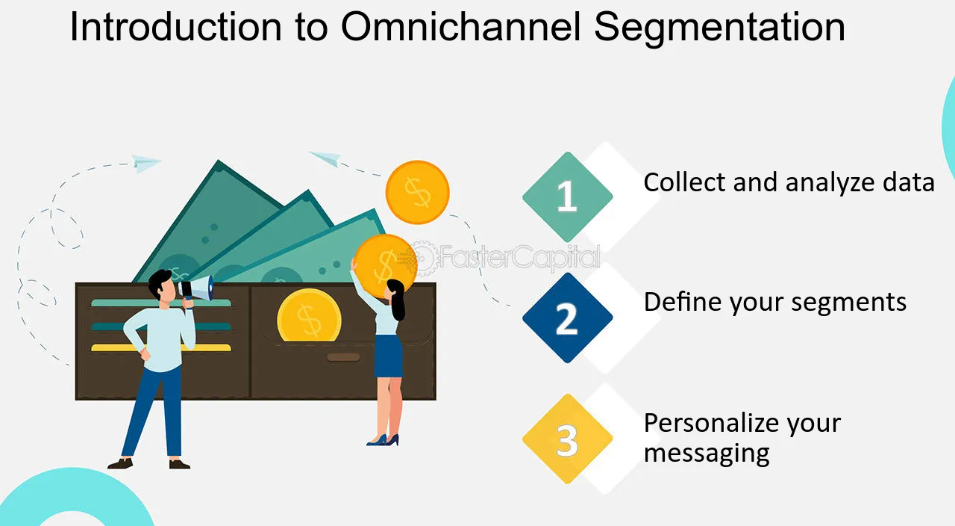
Omnichannel segmentation is a technique for dividing your customer base into distinct groups based on their behavior and preferences across all your touchpoints. This includes channels like websites, stores, social media, and email. Traditional segmentation focuses on dividing customers based on static characteristics, like demographics (age, income) or psychographics (interests, values). This creates groups like “young professionals” or “budget-conscious families.” Omnichannel segmentation, however, goes beyond these static attributes. It considers how customers interact with your brand across all channels. This can include factors like preferred shopping channels (online vs. in-store), browsing habits, past purchase history, and even how they respond to marketing messages on different platforms.
Analyzing this data can aid retailers in creating targeted marketing campaigns, delivering a more personalized shopping experience for each customer segment, and fine-tuning their marketing endeavors across various channels. Omnichannel segmentation not only facilitates effective customer engagement but also fosters enduring relationships, customer loyalty, and revenue growth in the long run.
Key benefits of omnichannel segmentation

- Enhanced personalization: Omnichannel segmentation allows businesses to tailor their marketing efforts and communication to individual customer segments based on their behaviors, preferences, and characteristics. This personalized approach increases relevance and engagement, leading to higher conversion rates and customer satisfaction.
- Increased sales and revenue: Omnichannel segmentation enables businesses to identify high-value customer segments and tailor their offerings and promotions to meet their specific needs and preferences. This leads to increased sales and revenue as customers are more likely to make purchases when presented with personalized and relevant offers.
- Data-driven insights: By analyzing customer data from multiple channels, businesses gain valuable insights into customer behavior, preferences, and trends. This data-driven approach allows businesses to make informed decisions and optimize their marketing strategies for better results.
- Improved customer experiences and smoother buying journeys: By providing a seamless and consistent experience across all channels, omnichannel segmentation ensures that customers receive the same level of service and attention regardless of how they interact with the brand. This enhances the overall customer experience and fosters loyalty and retention.
- Better targeting and engagement: By understanding customer segments more deeply, businesses can target their marketing campaigns more effectively and deliver relevant messages to the right audience at the right time. This increases engagement and response rates, driving higher ROI for marketing efforts.
- Deeper customer loyalty: Feeling valued and understood fosters customer loyalty. Omnichannel segmentation allows retailers to cater to individual needs and preferences, building stronger customer relationships.
The fundamental types of customer segmentation
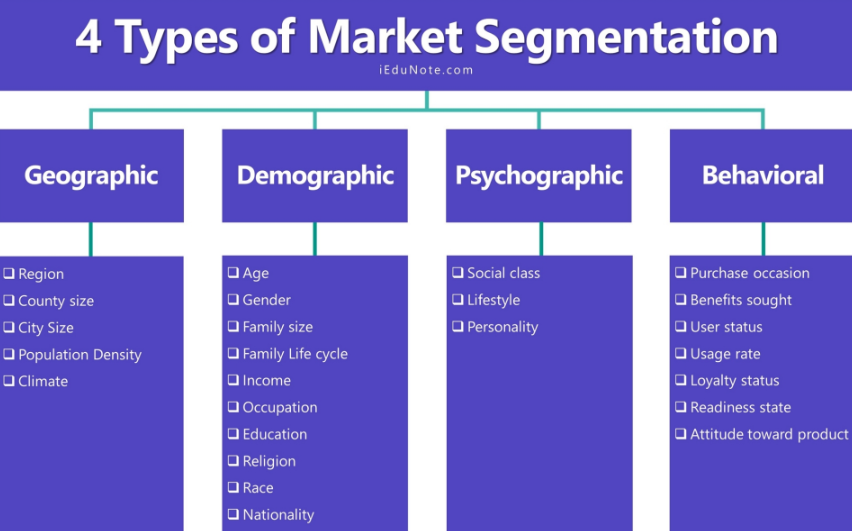
Demographic segmentation
Segmentation based on demographic factors such as age, gender, income, education, occupation, marital status, and location.
- Example: A clothing retailer may target different age groups with specific clothing lines (e.g., youth-oriented styles for teenagers and sophisticated designs for middle-aged adults).
- Use Cases: Tailoring marketing messages and product offerings to specific demographic groups, pricing strategies based on income levels, and determining store locations based on population demographics.
Psychographic segmentation
Segmentation based on lifestyle, personality traits, values, interests, attitudes, and opinions.
- Example: A travel company may target adventure-seekers with adrenaline-fueled excursions while offering relaxation packages to those seeking tranquility.
- Use Cases: Crafting marketing campaigns that resonate with specific lifestyles and interests, developing products that align with customers’ values and aspirations, and creating personalized content based on attitudes and opinions.
Behavioral segmentation
Segmentation based on customer behaviors, such as purchasing habits, brand loyalty, usage frequency, and product usage.
- Example: An online retailer may offer loyalty rewards to frequent shoppers or send personalized recommendations based on past purchases.
- Use Cases: Identifying cross-selling and upselling opportunities, designing targeted promotions for different buying behaviors, and optimizing product placement and pricing based on usage patterns.
Geographic segmentation
Segmentation based on geographic location, including country, region, city, climate, and population density.
- Example: A beverage company may adjust its product offerings based on regional preferences, such as offering hot drinks in colder climates and cold drinks in warmer regions.
- Use Cases: Localizing marketing campaigns to reflect regional preferences and cultural nuances, optimizing distribution channels based on geographic demand, and tailoring pricing strategies to account for variations in cost of living.
Developing a 360-degree omnichannel segmentation strategy for the retail industry
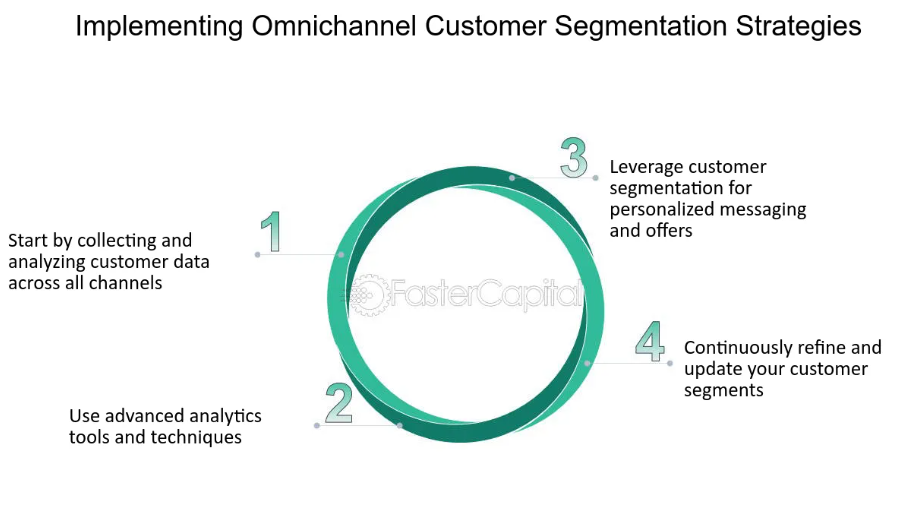
Step 1: Collect and analyze customer data across channels
Identify your key data sources
Building a successful omnichannel strategy hinges on a comprehensive understanding of your customer base. This requires collecting data from various touchpoints, including website analytics, point-of-sale systems, loyalty programs, email marketing campaigns, and social media interactions. By unifying this data, you gain a holistic view of customer behavior across all channels.
Useful tools for this task:
- Customer Data Platforms (CDPs): These platforms act as central hubs for collecting and managing customer data from various sources.
- Web analytics tools (e.g., Google Analytics): Provide valuable insights into website visitor behavior, browsing patterns, and purchase journeys.
- Social media listening tools: Help you track brand mentions, customer sentiment, and engagement on social media platforms.
Invest in a unified analytics platform
A unified analytics platform integrates data from all your sources into a single, centralized location. This eliminates data silos, reduces redundancy, and allows you to analyze customer behavior holistically. It provides a clearer picture of your customer journey and informs more effective segmentation strategies.
Useful tools for this task:
- Marketing cloud platforms: Offer a suite of tools for data management, analytics, and campaign automation across channels.
- Business intelligence (BI) tools: Enable you to visualize and analyze customer data from various sources, providing actionable insights.
Integrate your CRM
Your Customer Relationship Management (CRM) system stores valuable customer information like purchase history, demographics, and communication preferences. Integrating your CRM with your analytics platform creates a 360-degree view of each customer. This allows for highly personalized marketing efforts and improved customer service experiences.
Useful tools for this task:
- Open-source CRM platforms: Provide customizable solutions for managing customer data and interactions.
- Cloud-based CRM platforms: Offer scalability, accessibility, and integration with various marketing tools.
Implement tracking mechanisms
Utilize tools like website cookies, web beacons, and referral links to track customer behavior across your digital channels. This data allows you to understand how customers interact with your website, emails, and social media content. By analyzing this data, you can identify patterns and preferences for more targeted marketing efforts.
Useful tools for this task:
- Tag Management Systems (e.g., Google Tag Manager): Simplify the process of implementing various tracking codes and pixels on your website.
- Marketing Automation Platforms: This allows you to automate marketing campaigns based on customer behavior and segmentation.
Step 2: Map the customer journey
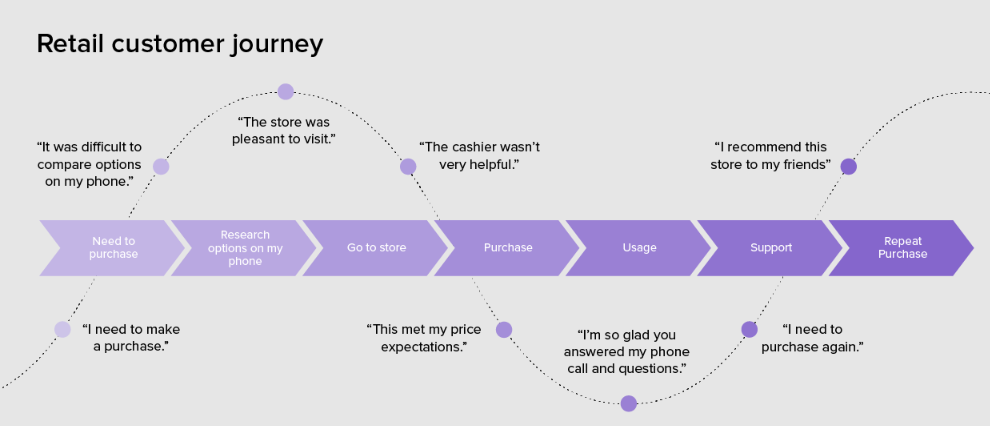
Define your customer personas
Customer personas are fictional representations of your ideal customers, capturing their demographics, psychographics, behaviors, needs, and goals. By creating these personas, you gain a deeper understanding of who your customers are and how they interact with your brand. This allows you to develop targeted messaging and experiences that resonate with each segment.
Useful tools for this task:
- Customer journey mapping tools: Help you visualize the customer journey across all touchpoints, pinpointing pain points and opportunities for improvement.
- Survey and feedback tools: Gather direct customer feedback to understand their motivations, preferences, and frustrations.
- Social media analytics tools: Analyze social media conversations to understand how customers talk about your brand and what content resonates with them.
Identify key touchpoints
A touchpoint is any point of interaction between a customer and your brand. Mapping these touchpoints across all channels (website, store, social media, email) helps you understand how customers move through the buying journey. Analyze which channels customers use for research, purchase, and post-purchase support.
Useful tools for this task:
- Customer journey mapping tools
- Web analytics tools
- Heat mapping tools: Visually represent how customers interact with your website, identifying areas of high engagement and potential drop-off points.
Chart the Journey
Plot the key touchpoints chronologically, illustrating the customer’s journey from initial awareness to purchase and post-purchase experience. Visualize the different channels customers utilize at each stage. This helps identify opportunities to personalize the experience and fill any gaps in the journey.
Useful tools for this task:
- Customer journey mapping tools
Analyze customer feedback
Actively collect customer feedback through surveys, reviews, social media comments, and support interactions. Analyze this feedback to understand customer pain points, preferences, and overall satisfaction with your brand across different touchpoints.
Useful tools for this task:
- Survey and feedback tools
- Social media listening tools
- Customer support ticketing systems: These allow you to categorize and analyze customer support interactions to identify trends and areas for improvement.
Iterate and refine
Customer journeys are not static. As you collect data and gather feedback, continuously refine your customer personas and journey maps. This ensures your segmentation strategy remains relevant and reflects evolving customer behavior.
Useful tools for this task:
- Customer journey mapping tools
- Customer Data Platforms
- Data visualization tools: They help you create interactive dashboards to track key customer journey metrics and identify areas for improvement.
Step 3: Segment your target customer
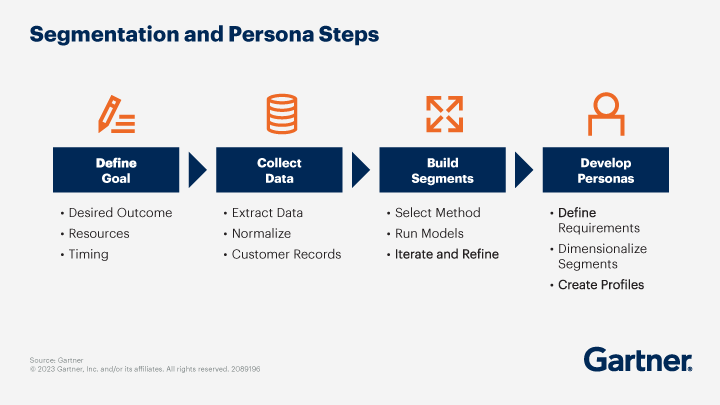
Identify segmentation criteria
Building on the data collected and mapping the customer journey, determine the most relevant criteria for segmenting your customer base. This can include a combination of factors like demographics (age, income), psychographics (interests, values), behavioral data (purchase history, channel preference), and loyalty program engagement.
Useful tools for this task:
- Customer Data Platforms
- Marketing Automation Platforms
- Data Analytics Tools: Provide advanced capabilities for data analysis and creating custom segmentation models.
Create customer segments
Based on your chosen criteria, group customers with similar characteristics and behaviors into distinct segments. This allows you to tailor your marketing efforts and personalize the customer experience for each segment.
Useful tools for this task:
- Customer Data Platforms
- Marketing automation platforms
- Data visualization tools
Analyze segment value
Evaluate the potential value of each customer segment. Consider factors like purchase frequency, average order value, and lifetime customer value (LTV). This helps you prioritize your marketing efforts and allocate resources effectively.
Useful tools for this task:
- Customer Data Platforms
- Business Intelligence (BI) tools
Step 4: Personalize the customer experience
Develop targeted content
Create content (emails, social media posts, website landing pages) tailored to the specific needs and interests of each customer segment. This could include product recommendations, educational content, or loyalty program updates.
Useful tools for this task:
- Content Management Systems (CMS): Provide platforms for creating and managing personalized content for different channels.
- Marketing automation and omnichannel customer engagement platforms
- Product recommendation engines: Recommend products to customers based on their purchase history, browsing behavior, and other relevant data.
Leverage dynamic offers
Utilize customer data to personalize offers and promotions for each segment. This could include targeted discounts, loyalty program rewards, or early access to new products.
Useful tools for this task:
- Marketing automation and omnichannel customer engagement platforms
- Customer Relationship Management (CRM) systems
Optimize the omnichannel experience
Ensure a seamless and consistent customer experience across all touchpoints. This means ensuring consistent messaging, branding, and promotions across your website, stores, social media, and email marketing.
Useful tools for this task:
- Customer journey mapping tools
- Marketing cloud platforms
Measure and refine
Continuously track the performance of your personalization efforts. Analyze metrics like open rates, click-through rates, conversion rates, and customer satisfaction. Use this data to refine your segmentation strategy, personalize content further, and optimize the overall customer experience.
Useful tools for this task:
- Web analytics tools
- Marketing automation and omnichannel customer engagement platforms
- Customer satisfaction surveys

Key things to consider when designing an omnichannel segmentation strategy
Consider these factors to develop a robust omnichannel segmentation strategy that unlocks the full potential of your customer data and personalizes the customer experience across all channels.
Customer data accessibility
Ensure that you have access to comprehensive customer data from all relevant channels, including online and offline touchpoints. This data should be centralized and integrated to provide a unified view of the customer.
Segmentation criteria
Define clear segmentation criteria based on relevant customer attributes, behaviors, and preferences. Consider factors such as demographics, psychographics, purchase history, engagement level, and channel preferences.
Customer journey mapping
Understand the typical customer journey across various touchpoints and channels. Identify key touchpoints where customers interact with your brand and map out their path from awareness to purchase and beyond.
Personalization opportunities
Identify opportunities for personalization at each stage of the customer journey. Tailor marketing messages, product recommendations, and promotions to meet the specific needs and preferences of different customer segments.
Channel integration
Ensure seamless integration and consistency across all channels to provide a unified and cohesive customer experience. Customers should be able to transition between channels effortlessly, with consistent messaging and branding.
Testing and optimization
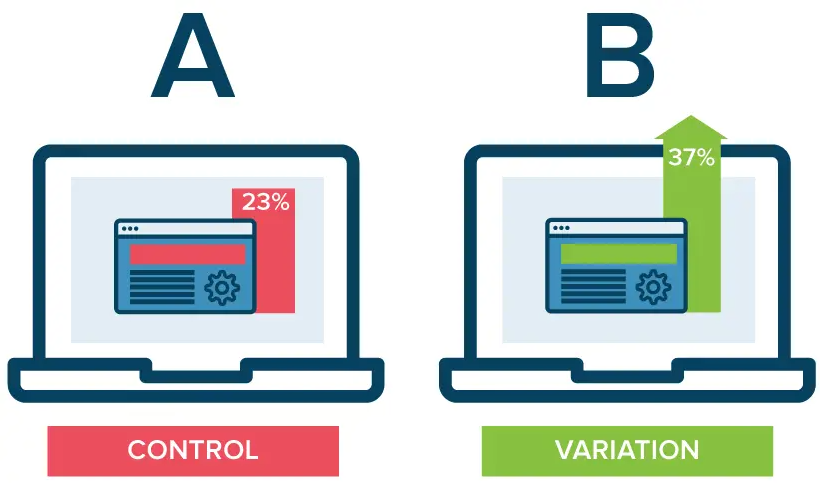
Continuously test and optimize your segmentation strategy based on data-driven insights and feedback. Monitor key performance indicators (KPIs) such as conversion rates, engagement levels, and customer satisfaction to measure the effectiveness of your segmentation efforts.
Flexibility and adaptability
Be prepared to adjust your segmentation strategy in response to changing market dynamics, customer preferences, and emerging trends. Flexibility and adaptability are essential for staying relevant and competitive in today’s dynamic retail landscape.
Privacy and data security
Ensure compliance with data privacy regulations and prioritize the security of customer data. Respect customer preferences regarding data usage and transparency, and implement robust security measures to protect sensitive information.
Cross-channel communication
Facilitate seamless communication and collaboration between different departments within your organization, including marketing, sales, customer service, and IT. Aligning cross-functional teams is essential for implementing and optimizing an omnichannel segmentation strategy effectively.
Customer feedback and insights
Gather feedback from customers across all channels to gain insights into their needs, preferences, and pain points. Use this feedback to refine your segmentation strategy and enhance the overall customer experience.
How to measure the effectiveness of your segmentation strategy
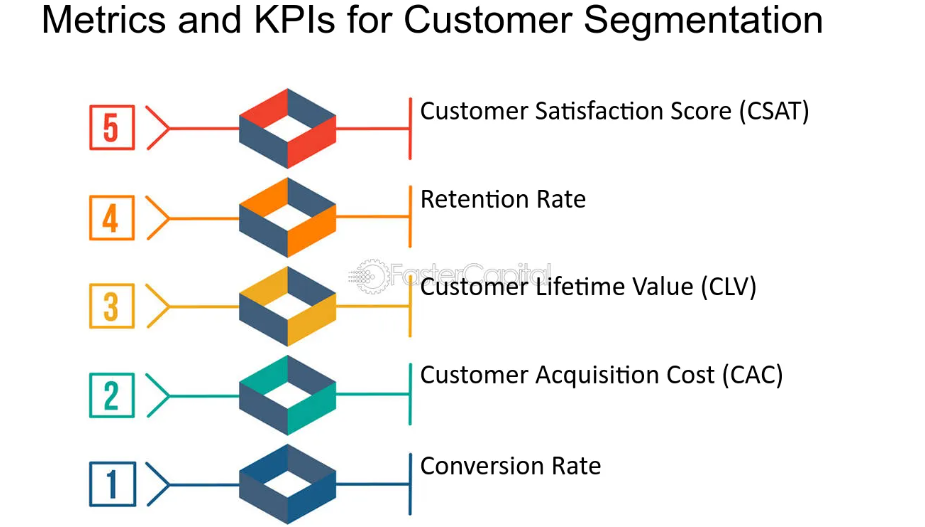
Segmenting your audience takes time and ongoing analysis. Refine your strategy as you learn more about your customer base. Don’t get overwhelmed by the number of metrics. Focus on a few key metrics that align with your segmentation goals.
Key performance indicators (KPIs)
- Brand awareness: Metrics such as Cost Per Impression (CPM), social media engagement metrics, and website traffic patterns.
- Segment performance: Conversion rates, average order value, customer lifetime value, and retention rates.
- Revenue contribution: Measure the contribution of each segment to overall revenue generation. Identify segments that drive the highest revenue and profitability, as well as those with untapped growth potential.
- Customer engagement: Email open rates, click-through rates, time spent on the website, bounce rates, website visits, and social media interactions.
- Return on investment (ROI): Calculate the ROI of your segmentation strategy by comparing the costs associated with segmentation (e.g., data analytics tools, and personalized marketing campaigns) to the incremental revenue generated or cost savings achieved. A positive ROI indicates that your segmentation efforts are generating value for the business.
Other metrics to track
- Customer satisfaction and loyalty: Monitor customer satisfaction scores, Net Promoter Score (NPS), and customer loyalty metrics within each segment.
- Cross-sell and up-sell opportunities: Analyze cross-selling and up-selling opportunities within each segment by tracking additional products or services purchased by customers.
- Churn rate reduction: Measure the impact of segmentation on reducing customer churn or attrition rates. Segments that exhibit lower churn rates compared to non-segmented customers demonstrate the effectiveness of targeted retention efforts.
- Customer feedback and sentiment analysis: Solicit feedback from customers within each segment through surveys, reviews, and social media interactions
- Benchmarking and comparative Analysis: Benchmark your segmentation strategy against industry standards and competitors to identify strengths and weaknesses
Choosing the right tools
The best reporting tools for your retail business will depend on your specific needs and budget. Here are some factors to consider:
- Company size & budget: Larger enterprises may require more sophisticated, enterprise-grade CDP and BI tools, while smaller businesses can leverage free or freemium options with core functionalities.
- Data integration capabilities: Ensure the tools you choose integrate seamlessly with your existing data sources like CRM, marketing automation platform, and e-commerce platform.
- Reporting features: Select tools that offer insightful dashboards and reports aligned with your segmentation goals and key metrics you want to track.
Reporting tools to utilize
- Customer Data Platforms (CDPs): CDPs are designed to collect and unify customer data from various sources. They provide insightful dashboards to monitor data completeness and consistency across your customer profiles.
- Customer experience (CX) management platforms: They offer features for journey mapping, customer satisfaction surveys, and feedback analysis. These can help you identify areas for improvement within the customer journey for each segment.
- Marketing automation platforms (MAPs): MAPs allow you to segment your audience and track the performance of targeted email campaigns, website content, and social media ads. They provide detailed reporting on each segment’s open, click-through, and conversion rates.
- Business Intelligence (BI) tools: Excellent for comprehensive business metric analysis. You can connect them to your sales data, marketing automation platforms, and e-commerce platform to track metrics like sales growth, customer acquisition cost, and customer lifetime value (CLTV) for each customer segment.
- Web analytics tools: Free and paid options are essential for tracking website traffic, user behavior, and conversion rates across different segments.
Omnichannel Segmentation: A critical component to unlock growth
The fiercely competitive retail environment dictates that a one-size-fits-all marketing approach simply won’t cut it. Customers expect a seamless and personalized experience across all touchpoints, from browsing your website to visiting your store. Omnichannel segmentation, the strategic practice of dividing your audience based on their interactions across every channel, empowers you to deliver exactly that.
This comprehensive guide has equipped you with the steps to implement this powerful strategy. Imagine the strategic advantage you’ll gain by crafting targeted messaging, recommending relevant products, and fostering deeper customer relationships – all based on a holistic understanding of your audience’s behavior. The results? Increased customer engagement, boosted sales, and a loyal customer base that sets you apart from the competition. Don’t wait – unlock the hidden growth potential within your customer data! Book a DEMO with ContactPigeon’s segmentation experts and discover how our cutting-edge Customer Data Platform can help you take your omnichannel marketing strategy to the next level.

Let’s Help You Scale Up





